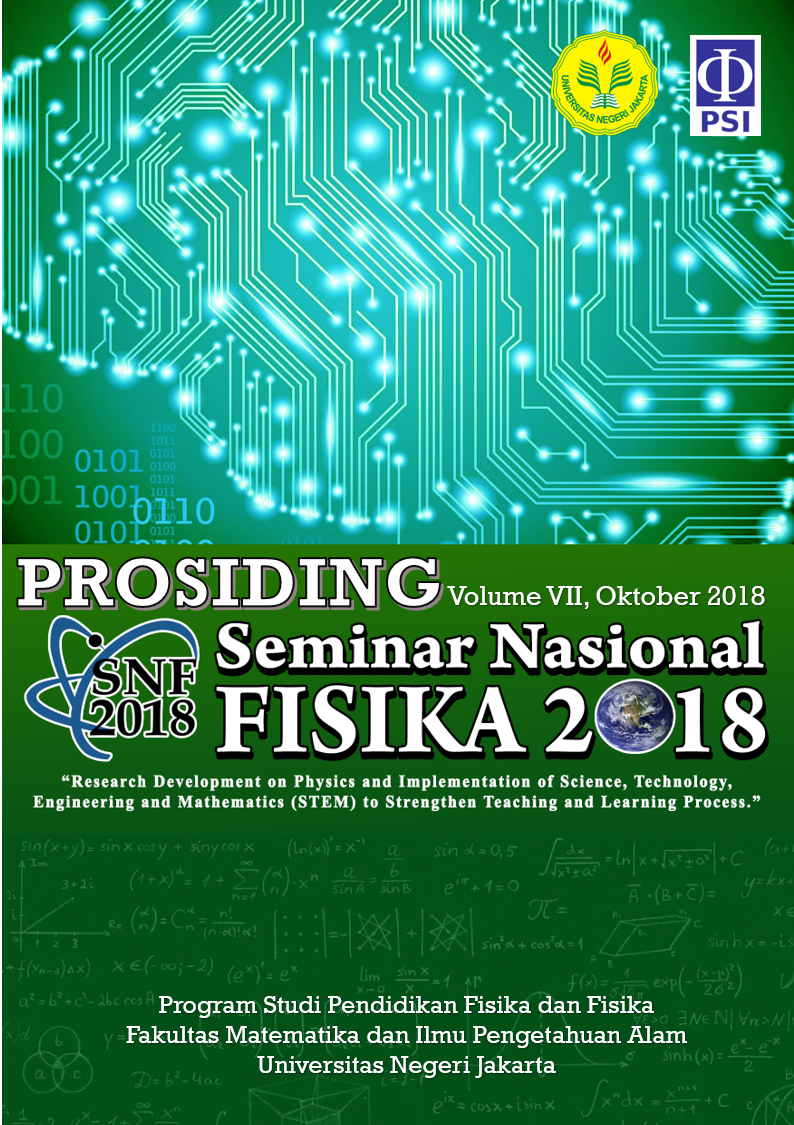ANALOGI MODEL OSILATOR HARMONIK LOGARITMIK PENDULUM TORSI DENGAN FLUKTUASI NILAI TUKAR RUPIAH TERHADAP US DOLLAR
DOI:
https://doi.org/10.21009/03.SNF2018.02.PA.07Abstract
Abstrak
Peristiwa fluktuasi nilai tukar rupiah terhadap US Dollar ada keserupaan dengan getaran paksa teredam. Untuk mengetahui adanya kemiripan fluktuasi nilai tukar rupiah terhadap US Dollar beserta faktor-faktor peubahnya dengan getaran paksa teredam, dilakukan uji model getaran paksa teredam menggunakan perangkat pendulum torsi. Untuk getaran paksa teredam sumber tegangan yang digunakan 8-8,4 V dan dengan nilai tukar rupiah terhadap US Dollar pada perioda tahun 2013 sampai 2017. Hasil analisis menunjukkan adanya kemiripan antara simpangan getaran paksa teredam dengan dinamika nilai tukar rupiah terhadap US dollar. Efek redaman pada getaran dianalogikan dengan kebijakan pemerintah untuk menstabilkan nilai tukar rupiah dan gaya paksa dianalogikan sebagai gangguan faktor eksternal. Hasil perhitungan melalui regresi sederhana dan SPSS diketahui koefisien pergerakan nilai tukar dan ampiltudo getaran mempunyai arah yang sama, yaitu arah positif. Dari uji korelasi melalui analisis deskriptif dan analisis inferensial diperoleh hubungan (korelasi) dengan kekuatan Sedang antara nilai tukar rupiah dengan simpangan getaran paksa teredam, dengan koefisien korelasi sebesar 0.595. Hal ini menunjukkan bahwa apabila nilai tukar naik (rupiah melemah), maka simpangan akan meningkat secara signifikan, sebaliknya jika nilai tukar menurun (rupiah menguat) maka simpangan akan menurun secara signifikan.
Kata-kata kunci: pendulum torsi, getaran paksa teredam, nilai tukar rupiah, uji korelasi.
Abstract
There are similarities between the Rupiah rate exchange against the US Dollar and forced damped vibration. To identify those similarities along with the variables of its effect with forced damped vibration, a forced damped vibration model is tested using a pendulum torque device. For forced damped vibration the voltage source used is 8-8.4 V and with the Rupiah exchange rate against the US Dollar from 2013 to 2017. The results of the analysis show that there are similarities between forced damped vibration and the dynamics of the Rupiah exchange rate against the US Dollar. The effect of attenuation on vibration is analogous to the government policy to stabilize the Rupiah exchange rate, and the forced force is analogous to the external factor disruption. The results of calculations through a simple regression and SPSS note that the exchange rate movement coefficient and vibration amplitude have the same direction, namely the positive direction. From the correlation test through descriptive analysis and inferential analysis obtained the relationship (correlation) with the medium strength between the Rupiah exchange rate with the forced damped vibration deviation, with a correlation coefficient of 0.595. This shows that if the exchange rate rises (the Rupiah weakens), then the deviation will increase significantly, on the contrary, if the exchange rate decreases (the Rupiah strengthens) then the deviation will decrease significantly.
Keywords: pendulum torque, forced damped vibration, Rupiah exchange rate, correlation test





